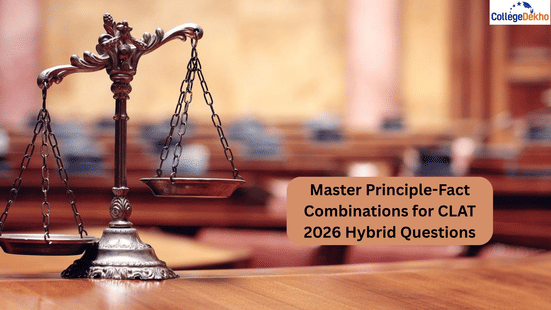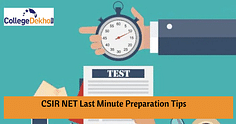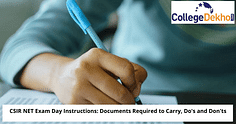Get to know in detail about how to master principle-fact combinations for CLAT 2026 along with some practice questions in this article.

From the legal reasoning section for CLAT exam, principle-fact questions are highly crucial as they test your legal aptitude more than your subject-oriented knowledge. Few test takers also claim that questions from this section are more of core reasoning and analytical skills which shape your career in the legal sector. Moreover, these questions carry a greater weightage from the reasoning section and therefore students must take this topic to score good marks and secure a decent rank in the CLAT 2026 exam. In the recent years from this topic, more hybrid or multi-principle questions are asked which are based on more than one legal principle or the principles combined with different realms of law. We can now begin the article.
Also Read: How to Keep Up with Legal Amendments for CLAT 2026Understanding Principle-Fact Questions for CLAT 2026
One of the easiest ways to successfully clear the CLAT exam is to score good marks particularly in this section. More than just testing your knowledge this topic tests your analytical skills, reasoning skills and how to arrive at the conclusion by combining the legal principle to a hypothetical situation presented in the question. The questions have the following three parts-
- Principle - This part of the question is the legal principle. To answer the question you are required to accept that the legal principle presented is appropriate despite being contradictory to the law.
- Facts - The facts that are presented in the question are hypothetical in nature describing any character or event which may or may not be relevant to the pertinent legal principle in the question.
- Opinion - Among the four given options you need to critically analyse which option is logical and follows the facts and legal principle in the question.
Comparison between Single Rule Questions and Hybrid Principle-Fact Questions
For the CLAT exam both these two types of questions are quite common. As a CLAT aspirant you must know the key difference between the two type of questions.
Feature | Single-Rule Questions | Hybrid Principle-Fact Questions |
|---|---|---|
Number of Rules | One, clearly stated rule. | Multiple, potentially conflicting rules or exceptions. |
Complexity | Simple and direct application. | Requires navigating conditional rules and exceptions. |
Facts | Simple, directly relevant to the rule. | More complex, with potential irrelevant details. |
Reasoning Process | Apply a single rule to a specific scenario. | Analyze multiple principles to determine which applies and how. |
Also Read: CLAT 2026 GK Questions: 5-Year Trend Analysis, Difficulty Level, Important Topics
How to Solve Principle-Fact Questions in CLAT 2026
Before attempting the question from this topic you should treat the legal principle mentioned in the question as a Truth and not use any knowledge or opinions contradicting the principle. Your work is to analyse the principle and the facts presented and come to a logical conclusion. Check the steps to know how to solve these types of questions.
- Carefully read the Legal Principle - Your first work is to read the legal principle very carefully as this is the section where the rule you need to apply for the answer is mentioned. In the legal principle, identify the conditions like ‘if”, "unless" , "except " mentioned in the question.
- Read the mentioned facts and connect with the Legal Principle - Once you go through the legal principle now go through the adjacent fact. Moreover, try connecting the facts to the conditions. For example if the legal principle mentions about “coercion” check whether the facts describe a coercive act.
- Use Logic - After reading the question identify the legal principle first and then move to the facts / situation that is mentioned. Before coming to the conclusion try to deduce a logical solution. Try to find the conclusion where the facts are satisfied with the principle.
Common Mistakes to Avoid While Solving Principle-Fact Questions
You should avoid the following mistakes at any cost.
- Do not use any prior knowledge - The principle that is mentioned in the question is the truth irrespective of any law against it. Follow the legal principle blindly. Do not use any prior knowledge related to the principle to come to conclusion.
- Do not Assume Facts - In the question check the facts that are mentioned. Do not assume anything unless mentioned in the question.
- Ignoring Keywords - One mistake that most candidates commit in the exam is ignoring the important keywords like “if” , “unless” etc. These words are the deciding factor. So it is important to read the question thoroughly before answering.
Important Questions from Principle-Facts for CLAT 2026
Check the questions from the below table.
Principle | Fact | Options | Correct Answer |
|---|---|---|---|
A person who enters into a contract with a minor is not entitled to enforce it. | A, aged 17, buys a bike from B on credit. Later, B demands payment. | (a) A must pay (b) A may pay if he wishes (c) B can sue A to recover money (d) A is bound to return the bike but not pay | (d) A is bound to return the bike but not pay |
No person shall be held guilty of an offence except for violation of a law in force at the time of commission. | A commits an act in 2023. A law making that act an offence is passed in 2024. | (a) A is guilty (b) A is not guilty (c) A may be punished retrospectively (d) Court has discretion | (b) A is not guilty |
Whoever causes injury by a dangerous animal is liable, unless the victim provoked the animal. | A’s dog bites B when B teases it. | (a) A is liable (b) A is not liable (c) B is liable (d) Both A and B are liable | (b) A is not liable |
Assault is an act that causes apprehension of imminent harm in another’s mind. | A raises a stick at B, but does not hit. B feels afraid. | (a) A committed assault (b) A committed no offence (c) A committed grievous hurt (d) A committed nuisance | (a) A committed assault |
Whoever finds goods belonging to another and takes them into custody must return them. | A finds B’s lost purse and keeps it. | (a) A is liable for theft (b) A is bound to return it (c) A can keep it as finder’s reward (d) A has no liability | (b) A is bound to return it |
A master is liable for acts done by his servant in the course of employment. | A driver employed by B negligently injures C while driving B’s car. | (a) Only driver is liable (b) Only master is liable (c) Both driver and master are liable (d) Neither is liable | (c) Both driver and master are liable |
Communication of offer is complete when it comes to the knowledge of the offeree. | A posts an offer letter to B. B has not yet read it. | (a) Offer is complete (b) Offer is not complete (c) Contract is already formed (d) B must accept immediately | (b) Offer is not complete |
The right of private defence does not extend to causing more harm than necessary. | A slaps B. B takes out a knife and stabs A fatally | (a) B acted in self-defence (b) B exceeded his right of self-defence (c) A is guilty (d) None | (b) B exceeded his right of self-defence |
An agreement made under coercion is voidable. | A threatens to kill B unless B sells land to him. B sells. | (a) Agreement is valid (b) Agreement is void (c) Agreement is voidable at B’s option (d) Agreement is enforceable only if registered | (c) Agreement is voidable at B’s option |
No person shall be deprived of his property except by authority of law. | A’s land is taken by the Government without passing any law. | (a) Legal deprivation (b) Illegal deprivation (c) Not a deprivation (d) None | (b) Illegal deprivation |
Whoever by words or signs brings the administration of justice into contempt commits contempt of court. | A publishes that all judges are corrupt. | (a) A has committed contempt (b) A has not committed contempt (c) A is exercising free speech (d) A is partly guilty | (a) A has committed contempt |
The occupier of premises owes a duty of care to lawful visitors. | A invites B into his house. The staircase breaks and B is injured. | (a) A is not liable (b) A is liable (c) B is liable (d) Both A and B are liable | (b) A is liable |
Reach out to us through toll free number 1800-572-9877. You can also get your doubts solved from our QnA zone . For detailed information on CLAT write to us on our Common Application Form .
Are you feeling lost and unsure about what career path to take after completing 12th standard?
Say goodbye to confusion and hello to a bright future!

Was this article helpful?





















Similar Articles
Can I pursue JD in the US after BA LLB from India?
Private Law Colleges in India Accepting AILET Scores
Delhi LLB Admission 2026
AILET 2026 Expected Cutoff for All Categories
What is a Good Score in AILET 2026?
AILET 2026 Expected Closing Cutoff Ranks for All Categories